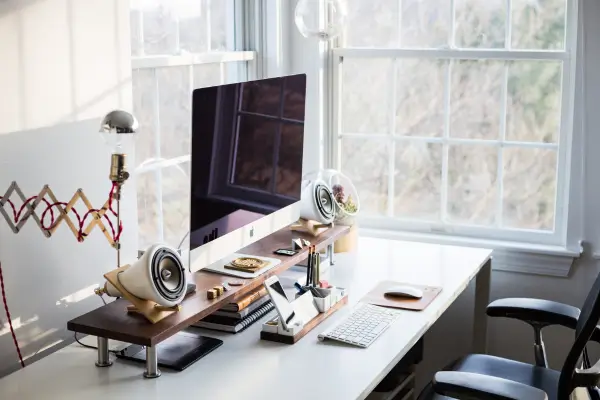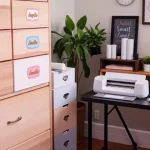Building a custom wooden desk is one of the most practical DIY projects for anyone working from home.
It gives you full control over size, layout, and storage to match your exact needs.
Instead of settling for a generic model, you can create a workspace that reflects your style and supports your routine.
Whether you need something compact or spacious, design flexibility is entirely in your hands.
This guide shows how to plan, build, and finish a wooden desk that’s both functional and uniquely yours.
Why Build a Custom Wooden Desk?
1. Perfect Fit for Your Space
Pre-made desks often don’t match the exact dimensions of your home office. A custom build ensures an ideal fit.
2. Cost-Effective
Creating your own desk can be more affordable than purchasing high-quality furniture, especially when using reclaimed or budget-friendly materials.
3. Personalized Features
From built-in drawers to adjustable shelving, you can design your desk based on your workflow and storage needs.
4. Higher Quality and Durability
Many store-bought desks use particleboard, while a custom-built wooden desk allows you to choose high-quality, solid wood materials.
Materials and Tools Needed
Before starting, gather the essential materials and tools:
Materials:
- Wood panels (oak, pine, birch, or reclaimed wood)
- Wood screws and nails
- Wood glue
- Sandpaper (medium and fine grit)
- Wood stain or paint
- Varnish or polyurethane finish
- Drawer slides (optional)
- Table legs or wooden supports
Tools:
- Measuring tape and ruler
- Saw (circular or hand saw)
- Drill and screwdriver
- Clamps
- Sander or sanding block
- Paintbrushes or foam applicators
Now that you have everything prepared, let’s start building your custom wooden desk step by step.
Step-by-Step Guide to Building a Wooden Desk
Step 1: Measure and Plan Your Desk
- Decide on the dimensions based on your available space.
- Sketch a basic blueprint of the desk, including the location of drawers, shelves, and any special features.
Step 2: Cut the Wood to Size
- Using your saw, cut the wooden panels according to your measurements.
- Cut the tabletop, side supports, and any additional shelving or drawer components.
- Sand the edges to ensure a smooth finish.
Step 3: Assemble the Desk Frame
- Secure the side panels to the desktop using wood screws and wood glue.
- If adding drawers, install support beams or tracks for drawer slides.
- Use clamps to hold everything in place while drying.
Step 4: Attach the Legs or Base
- Attach table legs or wooden supports to the underside of the desk using screws and brackets.
- Ensure they are level to prevent wobbling.
Step 5: Add Drawers or Shelves (Optional)
- Install pre-made drawer slides or construct simple storage shelves.
- Secure drawer fronts and handles if applicable.
Step 6: Sand, Stain, and Seal
- Sand the entire desk surface with fine-grit sandpaper to remove rough edges.
- Apply wood stain for a natural look or paint for a modern touch.
- Seal with a polyurethane finish for protection against scratches and spills.
Step 7: Final Assembly and Placement
- Once dry, place the desk in your workspace.
- Adjust height or leveling as needed.
Customization Ideas for Your Desk
1. Cable Management Solutions
- Drill a small hole at the back for cable pass-through.
- Use cable clips to keep wires organized.
2. Floating Shelf Additions
- Install floating shelves above the desk for extra storage.
3. Built-in Power Strip
- Attach a power strip underneath the desk for easy access to charging ports.
4. Ergonomic Adjustments
- Add adjustable legs for a standing desk option.
- Use a wrist rest pad or attach a keyboard tray for better posture.
5. Decorative Touches
- Incorporate a glass top for a sleek, modern look.
- Apply chalkboard paint to one side for writing notes.
Common Mistakes to Avoid
1. Not Measuring Accurately
- Always double-check dimensions before cutting wood to avoid wasted materials.
2. Skipping the Sanding Process
- Proper sanding ensures a smooth and professional finish.
3. Using the Wrong Type of Wood
- Softwoods like pine are great for beginners, while hardwoods like oak offer durability but require more effort to cut and assemble.
4. Rushing the Drying Process
- Let stain, paint, and glue dry completely before moving to the next step.
5. Ignoring Weight Support
- Reinforce with cross-bracing if your desk will hold heavy equipment like dual monitors or desktop computers.
Final Thoughts
Building a custom wooden desk is more than just a practical upgrade — it’s an opportunity to create a workspace that truly works for you.
With the right planning and materials, you can build a durable, functional piece that reflects your personal style and daily routine.
From the perfect dimensions to thoughtful finishes, every detail can be tailored to your needs.
Not only will you save money compared to buying high-end furniture, but you’ll also gain valuable skills and a workspace that boosts productivity.
Start your project today and transform your home office into a unique, custom-made environment — designed and built by you.



